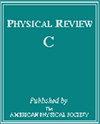NICER 数据和强子状态方程随σ场变化的刚度
IF 3.4
2区 物理与天体物理
Q1 Physics and Astronomy
引用次数: 0
摘要
对 NICER 数据的分析表明,在 1.4 至 2.0 太阳质量的质量范围内,紧凑星的半径没有明显变化。Yamamoto等人[Phys. Rev. C 108, 035811 (2023)]最近得出结论:"由于超子混合软化了状态方程(EoS),强子物质无法再现这一特征,这表明中子星内部可能存在夸克相"。利用 CompOSE 数据库中的 162 个纯核、超子和夸克状态方程集合以及其他一些研究成果,我们验证了超子确实导致了 1.4 和 2.0 太阳质量恒星半径的显著差异,这种差异在存在夸克时会减小。我们比较了质量-半径曲线的形状,结果表明,中子星内核中的超子和夸克偏爱一种具有反弯曲的特定曲线形状。我们认为,这种形状是由核对称性能量的密度依赖性控制的。我们提请注意存在一类纯强子相对论均场 EoS,其强子质量和耦合常数依赖于标量场,满足对 EoS 的已知约束,包括对新 NICER 数据的分析和上述中子星半径变化不明显的要求。本文章由计算机程序翻译,如有差异,请以英文原文为准。

NICER data and a σ-field-dependent stiffness of the hadronic equation of state
Analyses for the NICER data indicate that there is no significant variation of compact star radii within the mass range of 1.4 to 2.0 solar masses. Yamamoto et al. [Phys. Rev. C 108, 035811 (2023)] concluded recently that “this feature cannot be reproduced by the hadronic matter due to the softening of the equation of state (EoS) by hyperon mixing, suggesting the possible existence of quark phases in neutron-star interiors.” Using a collection of 162 purely nucleonic, hyperonic, and quarkish EoSs from the CompOSE database and some other works, we verify that hyperons indeed lead to a significant difference in radii of stars of 1.4 and 2.0 solar masses, which diminishes in the presence of quarks. We compare the shapes of the mass-radius curves and show that hyperons and quarks in the neutron star cores prefer a particular curve shape with backbending. It is argued that the shape is controlled by the density dependence of the nuclear symmetry energy. We draw attention to the existence of a class of purely hadronic relativistic mean-field EoSs with scalar-field dependent hadron masses and coupling constants that satisfy the known constraints on the EoSs including the analyses of the new NICER data and the above requirement of insignificant variation of the neutron star radii.
求助全文
通过发布文献求助,成功后即可免费获取论文全文。
去求助
来源期刊

Physical Review C
物理-物理:核物理
CiteScore
5.70
自引率
35.50%
发文量
0
审稿时长
1-2 weeks
期刊介绍:
Physical Review C (PRC) is a leading journal in theoretical and experimental nuclear physics, publishing more than two-thirds of the research literature in the field.
PRC covers experimental and theoretical results in all aspects of nuclear physics, including:
Nucleon-nucleon interaction, few-body systems
Nuclear structure
Nuclear reactions
Relativistic nuclear collisions
Hadronic physics and QCD
Electroweak interaction, symmetries
Nuclear astrophysics
 求助内容:
求助内容: 应助结果提醒方式:
应助结果提醒方式:


